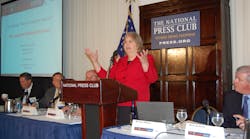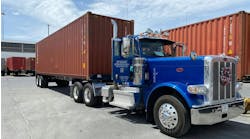An annual in-depth analysis of the U.S. logistics industry concludes that a major truck capacity shortage is in the works for the U.S. transportation and logistics system; a crunch that is driving shippers to find other options, especially intermodal service, for moving their freight.
“Capacity issues are on the horizon and I urge everyone to begin making contingency plans for the day when you cannot get a truck,” said Rosalyn Wilson, senior business analyst with Declan Inc. and the primary author of the annual State of Logistics report published by the Council of Supply Chain Management Professionals (CSCMP) and sponsored by Penske Logistics.
[To watch some of Wilson’s presentation, please click here.]
“Right now, capacity in the trucking industry is in a tenuous equilibrium state,” she explained in a press conference held at the National Press Club in Washington D.C. this week, and while true shortages remain rare right now, available capacity is just not “abundant” in her words.
“The bottom line is that by every measurement, the trucking industry is compressing,” warned Wilson. “There are less trucks, less drivers, and fewer [trucking] companies. Carriers have ‘leaned’ their fleets and will continue to do so. As a result, paying higher [trucking] rates going forward won’t be as much of a worry for shippers as not being able to find a truck to move their freight.”
A panel of logistics experts gathered by CSCMP to discuss the report’s findings – drawn from the ranks of shippers and transportation companies alike – largely agreed with Wilson’s analysis of the truck capacity situation.
“I would say we’re now getting past the point of ‘equilibrium’ in terms of truck capacity,” noted Rick Sather, vp-North American supply chain for retailer Kimberly Clark.
“We’ve seen a steady increase in what we call ‘delivery failures’ in terms of finding available trucks to haul our goods,” he said. “As a result, inventory levels are going back up as the trade-offs between service levels, cash and expense are re-examine. This is going to create an interesting transportation dynamic over the next two to three years.”
Railroads in particular stand to benefit from this developing truck capacity crunch, according to the “State of Logistics” report. Declan’s Wilson noted in her presentation that more trucking companies are partnering with railroads for intermodal service to avoid problems caused by the driver shortage as well as avoid the cost of acquiring new equipment.
Indeed, the report cited research by Union Pacific that indicates if truckload capacity decreases 5%, it could equate to a 29% increase in total intermodal loads.
Third party logistics providers foresee an opportunity in this projected reduction in trucking capacity as well, noted Joseph Gallick, senior vp-sales wit Penske Logistics.
“This ‘modal shift’ is good for us, as we’re seeing a corresponding rise in the willingness and ability to shift to dedicated contract carriage,” he said the conference. “As capacity gets tighter and rates escalate, we see growth in more dedicated-style fleet operations.”
Declan’s Wilson also pointed out, however, that while trucking rates increased between 5% and 15% in 2011, costs continued to rise as well in terms of driver pay, rising insurance premiums, diesel fuel prices, and equipment prices. That’s why she believes capacity will continue to decline, even though trucking profits are nominally on the increase.
“Within the transportation sector there are conflicting signs,” Wilson said. “Some carriers are ordering new equipment and preparing for returning volumes, while others are deciding whether or not to stay in business.”
She added that a Transport Capital Partners (TCP) survey conducted in January this year indicated almost 3/4ths of those carriers polled either did not plan to add capacity or would keep capacity additions to their fleet under 5%.
“Further, 28% of the truckers [in the survey] said they are considering selling out in the next 18 months if conditions don’t improve,” Wilson noted. “That’s the highest total percentage since the survey began almost three years ago.”



